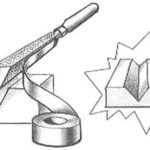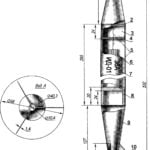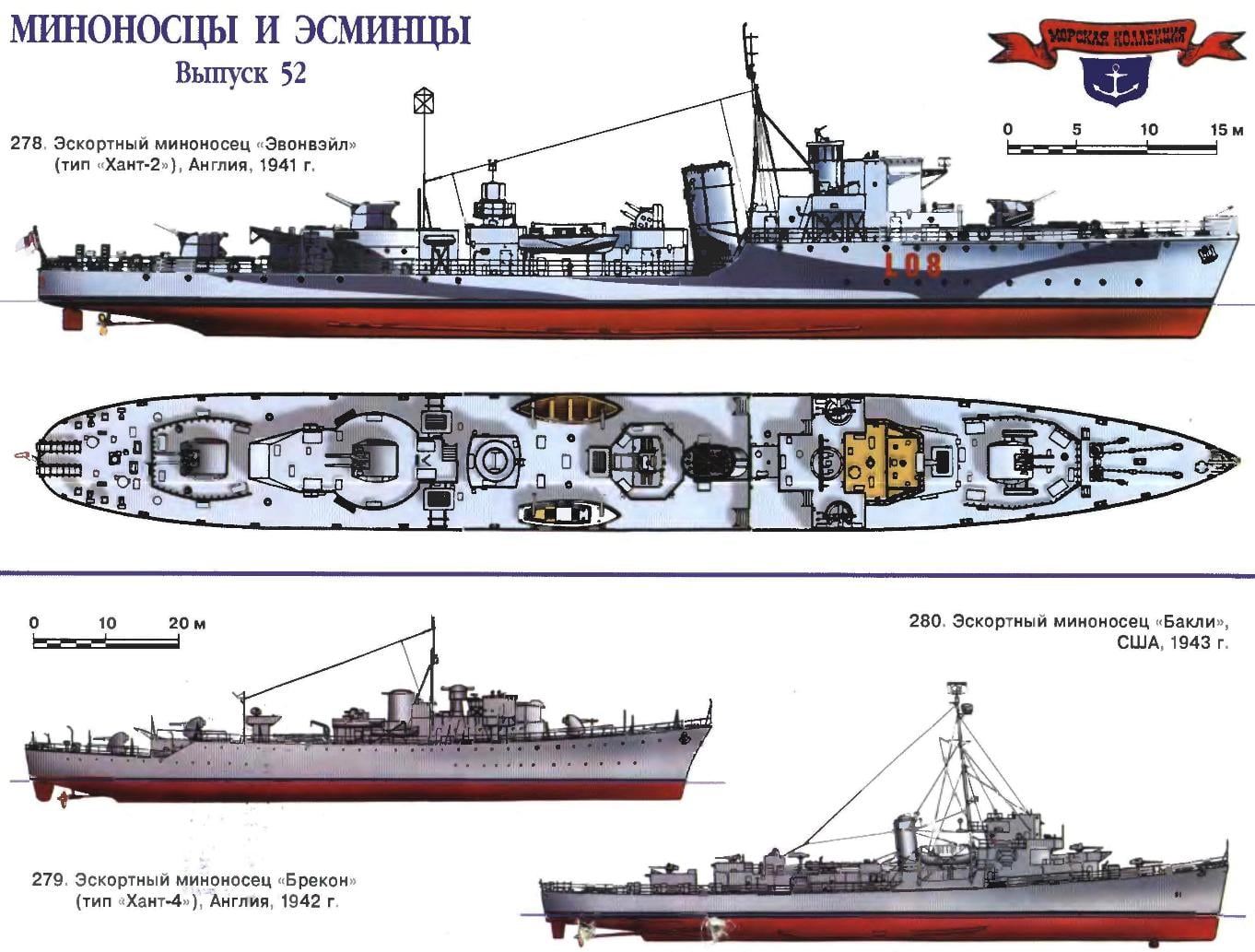 Inevitably looming at the end of the 30-ies of the threat of war forced the British Admiralty to take all possible measures to strengthen the fleet, and to do this required quickly and at minimal cost. If the ensuring action of the fighting force of the fleet one way or another was solved through the construction of various types of destroyers, as we told you in previous issues, the issue of the protection of navigation in the waters surrounding Britain and her possessions, looked much sharper. Three dozen sloops, mostly obsolete, slow moving, not able to ward off even the plane-“whatnot” — that could oppose the “mistress of the seas” potential enemy for tens of thousands of miles coastal strip of the Empire, which yet “never the sun went down”.
Inevitably looming at the end of the 30-ies of the threat of war forced the British Admiralty to take all possible measures to strengthen the fleet, and to do this required quickly and at minimal cost. If the ensuring action of the fighting force of the fleet one way or another was solved through the construction of various types of destroyers, as we told you in previous issues, the issue of the protection of navigation in the waters surrounding Britain and her possessions, looked much sharper. Three dozen sloops, mostly obsolete, slow moving, not able to ward off even the plane-“whatnot” — that could oppose the “mistress of the seas” potential enemy for tens of thousands of miles coastal strip of the Empire, which yet “never the sun went down”.
The solution was to create a new type of ship, suitable for air defense and ASW, as well as the ability if necessary to stand up for themselves (and for escorted merchant ships) in the battle with the surface forces of the enemy. Its small size was dictated by the requirement of cheapness and speed of construction. In search prototype, the specialists chose a built in 30-ies of the sloops of the “black Swan” — tasaciones strong ships, armed with six or eight 102-mm anti-aircraft guns in paired installations. Essentially, their only drawback was speed, not exceeding 20 knots. Extra developed a new “optimistic” the project was well within the scheme of “all on four”. 800 tons displacement, the designers were going to “drive” a specified number of 102-mm and 40-mm guns and torpedo tubes, as well as mechanisms to ensure speed to 31 knots! It turned out a kind of English “That majuru” (about it later) with the apparent lack of stability already on the paper. Attempts to rectify the situation led to the increase in displacement of 100 tons and replacement chetveronogo heavy torpedo tubes to the third 102-mm gun spark. So there is a new class of warships, dubbed the “destroyer escort”, which in Russian literature is translated as “escort destroyer,” though literally means “destroyer escort”. However, both of these names are conditional and, in principle, meaningless, because the main attribute of the destroyer — torpedo weapons on the new ships was not.
The fever with the construction of “escortscom” in the last few months of peace in 1939 went so far that a series of 19 units laid even before the completion of all calculations on the stability of ships. Only when the head “Atherton” preparing for the commissioning, it became clear that with the planned armament it one way — at the bottom, and without the intervention of the enemy. Had to remove one of the three 102-mm installations, narrowing his eyes, send the ship to the test. Surprisingly, they ended quite well, and the entire series (up to 22 units) came into operation with similar armament. However, displacement full load exceeded the initial project almost doubled, and the rate almost reached 27 knots. Beginners names corresponded to the names of the hunting grounds and the type received the designation “hunt” (hunt — hunt).
If you do not take into account the obvious “flaw” with the design load, then re-entered the class was very useful. So in February 1940, a month before the entry into operation of the first “hunt”, on the slipway laid head “escortin” an improved project. This time the designers took into account their mistakes and have significantly increased the width of the body, which allowed to return to its rightful place the third 102-mm spark. Increase the power of anti-aircraft half — act more than useful given the trouble that has been caused and still causing to the British by the German air force. Fell slightly the maximum speed, but overall 33 “hunt” of the second series have become a significant strengthening of the British fleet.

278. Escort destroyer”, Manual” (such as “hunt-2”), England, 1941
It was built by the firm “Traun”. The standard displacement of 1050 tons, full 1610 t maximum Length of 85.3 m, width 9.6 m, draft 2,36 m. Capacity twin-shaft turbine installations 19000л.. speed of 29 knots. Armament: six 102-mm universal guns, four single 40-mm machine gun, two mortars and two release gear. Only in 1941 -1942 was built 23 units, seven of them died during the war. Another 28 ships are built on very similar projects “hunt-3”.
279. Escort destroyer “Brecon” (the “hunt-4”), England, 1942
It was built by the firm “thornycroft”. The standard displacement of 1180 tons, the complete 1590 T. maximum Length 90,2 m, width of 10.15 m, draft 2,43 m. Capacity twin-shaft turbine installation 19 000 HP, speed 25 knots. Armament: six 102-mm universal guns, four 40-mm and two 20-mm machine gun, two mortars and one release gear. Just built two units: “Brecon” and “Brissenden”. In wartime anti-aircraft armament increased to four 20-mm machine gun. Both excluded from the lists in 1962-1965.
280. Escort destroyer”, Bake”, USA, 1943
Built by “Bethlehem”. The standard displacement of 1440 tons, full 1835 T. maximum Length 93,27 m, width of 11.28 m, draft 3,43 m. Capacity twin-shaft turbo-electric installation 12 000 HP, speed 23 knots. Armament: three 76-mm universal guns, four 28-mm and eight 20-mm guns, three-pipe 533-mm torpedo tubes, six mortars and two release gear. Only in 1943-1944 built 102 units.
At the end of that year was followed by an order for 30 more escort destroyers. This time the prevailing pressure “torpedo lobby”, and the project was returned to the torpedo, however, only a twin. The price for it seemed high enough: they had to remove one 102-mm launchers, and mortars. As compensation for the weakening of the main armament — an increased supply of depth charges and an additional three 20-mm “Oerlikon” — were clearly inadequate.
However, two of the ordered ships escaped the common fate. They were built under the project developed by “thornycroft”, and in General terms the repeated option, was rejected in 1938 due to a too low speed. “Khanty-4” (a designation they received) was very long and forecastle “incarnum” square section at the midsection. Perhaps, they became the most balanced and harmoniously equipped with escorts. In wider and longer body managed to combine three 102-mm twin anti-aircraft guns and three-pipe torpedo tubes, and a higher capacity fuel tank. Significantly increased the seaworthiness and autonomy. However, the rate fell to 25 knots, but it seemed sufficient for any anti-submarine action became the main occupation forces of the allies cover the second half of the war.
Escort destroyers successfully fought first in the waters of the English channel, and then in the Mediterranean and the Atlantic, participated in the transaction convoys and covering landing forces. In the course of repairs on them, as a rule, established additional “erlikon” and different radar equipment.
As can be seen from the evolution of the “hunt”, the British could successfully develop their own types of fast escort ships, if not… help “American uncle”. In the United States have addressed similar tasks extremely efficient and technologically advanced. As soon as the shouts of the British on assistance became urgent to go to desperate, they began to mass building that can hardly be called a destroyer, even an escort. The hulls of these ships were going conveyor method with the total welding. The lack of a staggering number of turbines and in particular of the gear to them, has led to the use in some series turbo-electric and the other diesel-electric units, reduced speed from 24 knots to the critical 21. Artillery weapons are few, if any, suitable for surface combat: three 76-mm universal guns older models the British who first saw them dubbed the “guns for hunting elephants.” (By the way, their ships, the Americans preferred to install two universal 127-graph paper.) However, most of the shortcomings were offset by excellent at the time of the anti-submarine equipment, including sonar, six mortars, a couple of release gear and a new weapon — reactive mortars “Hedgehog”.
Just by the spring of 1943, the Americans approved orders 1005 (!) escort destroyers of various modifications. This number was excessive, and later of the orders cancelled. However, in a system included 563 units on such a scale they could only build US. And in the end, the allies managed to solve a very difficult task — to provide cover tens of thousands of commercial and military cargo vessels.
281. The destroyer “Tomozuna”, Japan, 1934
Built at the shipyard of the Navy in Maizuru. Displacement standard 535 tons full 737 T. maximum Length 82 m, width 7.4 m, draught 2.5 m. Capacity twin-shaft turbine installations 11 000 HP, speed 30 knots. Armament: three 127-mm guns, one 40 mm gun, two 533-mm twin-tube torpedo tubes. Just in 1933-1934 built four units: “Tomozuna””, “Manazuru”, “Chidori” and “Hatsukari”. The first three died in 1944-1945, “Hatsukari” scrapped in 1946.

282. The destroyer “Torn”, Japan, 1936
Built at the shipyard of the Navy in Maizuru. The standard displacement of 850 tons, full 1050 T. maximum Length 88.5 m, width of 8.18 m, draft of 2.76 m. Capacity twin-shaft turbine installation 19, OOO HP, speed of 30.5 per node. Armament: three 120-mm guns, one 40 mm gun, one 533 mm torpedo tube three-pipe. Just 1936-1937 built eight units: “Acorn”. “Kassagi”, “Hitori”, “Hayabusa”, “Hato”, “Saga”, “brown” and “Kizi”. All except “Kiji”, died in the years 1943-1945, the latter after the war was transferred to the Soviet Union.

283. Escort destroyer “matsu”, Japan, 1944
Built at the shipyard of the Navy in Maizuru. The standard displacement of 1260 tons, full 1550 T. maximum Length is 100.01 m, width of 9.35 m, draft 3,3 m. Capacity twin-shaft turbine installation 19 000 HP, speed of 27.5 knot. Armament: three 127-mm anti-aircraft guns, twenty-four 25-mm machine gun, the release gear for depth charges. Only in 1944 was built 18 units, of which seven were killed, eight after the war distributed among the allies (two transferred to the United States, USSR, England and China), the other three scrapped in 1948.
Much worse things were their opponents, especially in Japan. In 30-e years when there were limitations of the London naval Treaty, the efforts of designers this country has focused on trying to create a decent combat ship within 600 t maximum provided for a class of destroyers. At first glance, they succeeded brilliantly. Founded in 1931-1932 four-unit type “Tomozuri” on paper combined maximum combat power in the minimum volume. Three powerful 127-mm guns in the tower installations (one twin and one single), three-pipe torpedo speed 30 knots — and it all managed to fit in a 535 tons displacement. Weapons took up nearly 23 percent of the total load — a figure quite worthy of a battleship! It seemed that Japanese shipbuilders failed to make the next shipbuilding miracle.
But it’s on paper, but in reality it was much more difficult. Less than a month after the entry into operation of the head “Tomozuri” on maneuvers is caught in a storm and overturned on a flat course, killing a significant part of the team. “Drowned” was towed keel upwards into the port, put in the dock and proceeded to a radical alteration. All the ambitious artillery and torpedo armament was sent to the warehouse, and instead installed the old single 120-graph paper with manual control. The bridge and superstructure were cut, replacing them with lower design. In the holds added about 100 tonnes of ballast — almost a fifth of the original weight of the vehicle! Similar operations have been, and the rest of the destroyers, some of which, fortunately, was still on the stocks. In General, instead of brilliant, but maloobyasnimoe ideas to be 800-ton destroyer with mediocre speed (28 knots) and outdated weaponry, close in its parameters to the same courts martial during the First world war.
Paradoxically, the disaster with the “Tomozuna”, even with the human tragedy, was very timely. Hard to imagine how many Japanese sailors could die later if the design and construction of similar ships continued. Now I had to take emergency measures. Significant changes have been small destroyers, but the destroyers, as has already been mentioned when describing the history of the “special” types.
However, pure Menomonie experiment was repeated, now right in a modified form. Ordered on the program, 1934 16 ships of the type “Atari” had a wider, lower add-ons and adjusted the arms. It is interesting that to maintain the design speed of previous type had to increase capacity by more than 70 percent. On contractual restrictions somehow managed to forget, and perhaps the designers of other countries believed in the official 600 so they Probably made their conclusions about the irrationality of such vessels in General and not to repeat the mistakes of others. However, in Japan the construction of half of the ordered ships are canceled, and in the further development of this line has not received.
To return to the construction of the Japanese destroyers made a huge loss their great destroyers during prolonged carnage around Guadalcanal in 1942. Conversion of obsolete units times 20 years in escorts and escort could not fill the gap, which increasingly penetrated the American submarines and planes. And again, the designers of the rising sun demonstrated its potential, quickly making a very simple and feasible project. Simple hull shape, wide application of electric welding, a good mix of combat elements… In accordance with the behest of time out of the typical escort destroyer: type “matsu” had guns of the same caliber as destroyers, but in fact it was the other guns, short and with a small initial velocity, but with the ability to lead a full anti-aircraft fire. Consistent with the appointment and installation (single nose and coaxial in the rear), which had electro-hydraulic drive. Initially it was assumed the numerous anti-aircraft guns. However, “escortin” could hurt much any surface enemy: the weapons included torpedo tube with the famous 610-mm “long spears”. For the first time in Japan at such a small ships from the very beginning provided for the installation of two radars. In General, savings on the comfort of the crew and, more significantly, on the equipment, the Japanese again managed to “beat” the allies, at least on purely formal characteristics, as is easily seen, comparing them with the escort destroyers of the United States and England. However, as with other types of military equipment, it’s too late. Hundreds of Union “escortscom” resisted all 18 units of the type “matsu” and 14 “Tachibana” which was a further simplification of the first, to the extent that they are completely welded together from mild steel. However, the time of their appearance “on stage” theater of military operations (mainly April — June 1945) leaving the possibility of only one outcome — to be flushed by the hordes of American aircraft before they could bring any military benefit.
V. KOFMAN
Recommend to read
 UNNECESSARY TO SEAL
UNNECESSARY TO SEAL
If the angular groove in the part requires the processing of a triangular file, but only one side with a notch (nearby to not participate in it), tape it temporarily any adhesive tape... A MODEL ROCKET CLASS S6A FROM KARELIA
A MODEL ROCKET CLASS S6A FROM KARELIA
Over the past 3 — 4 years in the lists of winners of major Russian competitions in sport flying are increasingly common names "rocket scientists" of the Republic of Karelia. So, on...
 Inevitably looming at the end of the 30-ies of the threat of war forced the British Admiralty to take all possible measures to strengthen the fleet, and to do this required quickly and at minimal cost. If the ensuring action of the fighting force of the fleet one way or another was solved through the construction of various types of destroyers, as we told you in previous issues, the issue of the protection of navigation in the waters surrounding Britain and her possessions, looked much sharper. Three dozen sloops, mostly obsolete, slow moving, not able to ward off even the plane-“whatnot” — that could oppose the “mistress of the seas” potential enemy for tens of thousands of miles coastal strip of the Empire, which yet “never the sun went down”.
Inevitably looming at the end of the 30-ies of the threat of war forced the British Admiralty to take all possible measures to strengthen the fleet, and to do this required quickly and at minimal cost. If the ensuring action of the fighting force of the fleet one way or another was solved through the construction of various types of destroyers, as we told you in previous issues, the issue of the protection of navigation in the waters surrounding Britain and her possessions, looked much sharper. Three dozen sloops, mostly obsolete, slow moving, not able to ward off even the plane-“whatnot” — that could oppose the “mistress of the seas” potential enemy for tens of thousands of miles coastal strip of the Empire, which yet “never the sun went down”.






